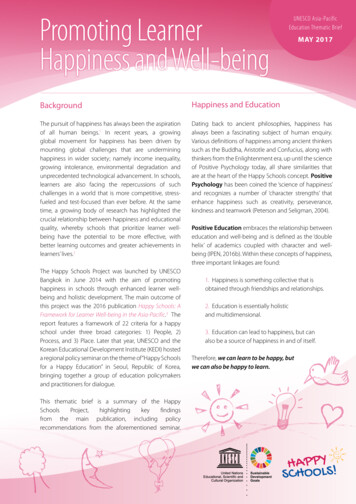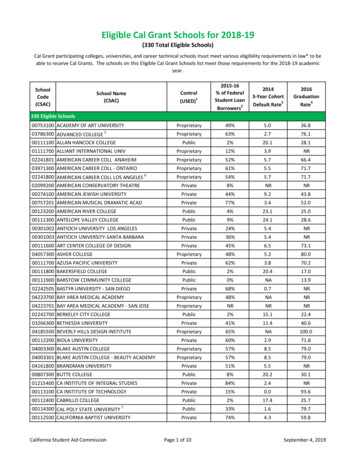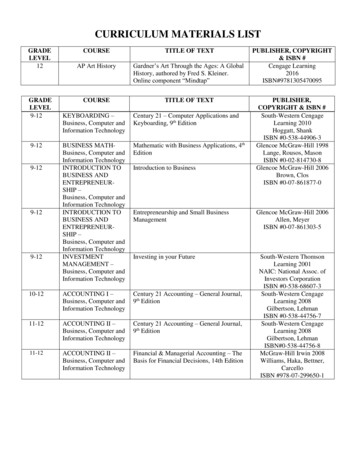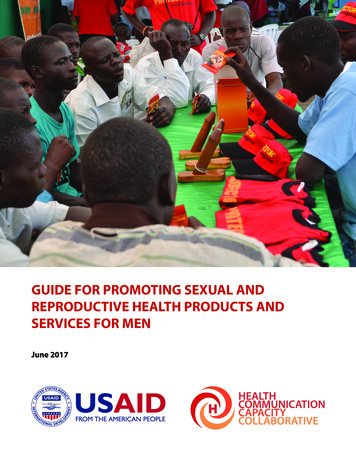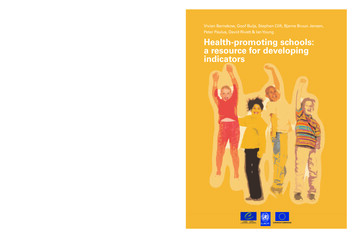
Transcription
Vivian Barnekow, Goof Buijs, Stephen Clift, Bjarne Bruun Jensen, Peter Paulus, David Rivett & Ian YoungHealth-promoting schools: a resource for developing indicatorsEuropean Network of Health Promoting SchoolsVivian Barnekow, Goof Buijs, Stephen Clift, Bjarne Bruun Jensen,Peter Paulus, David Rivett & Ian YoungHealth-promoting schools:a resource for developingindicatorshttp://www.euro.who.int / ENHPSCOUNCILOF EUROPECONSEILDE L'EUROPE
International Planning Committee (IPC) 2006All rights in this document are reserved by the IPC of the European Network ofHealth Promoting Schools, a tripartite partnership involving the WHO RegionalOffice for Europe, the European Commission and the Council of Europe.The IPC welcomes requests for permission to reproduce or translate its publications, in part or in full.The designations employed and the presentation of the material in this publication do not imply the expression of any opinion whatsoever on the part of theIPC or its participating members concerning the legal status of any country,territory, city or area or of its authorities, or concerning the delimitation of itsfrontiers or boundaries. Where the designation “country or area” appears in theheadings of tables, it covers countries, territories, cities, or areas. Dotted lines onmaps represent approximate border lines for which there may not yet be fullagreement.The mention of specific companies or of certain manufacturers’ products doesnot imply that they are endorsed or recommended by the IPC in preference toothers of a similar nature that are not mentioned. Errors and omissions excepted,the names of proprietary products are distinguished by initial capital letters.The IPC does not warrant that the information contained in this publication iscomplete and correct and shall not be liable for any damages incurred as a resultof its use. The views expressed by authors or editors do not necessarily representthe decisions or the stated policy of the IPC.Text editing: David BreuerLayout and printing: Kailow Graphic
268600 WHO bog v4:268600 WHO bog14/12/0614:42Side 3Health-promoting schools:a resource for developingindicatorsVivian Barnekow, Goof Buijs, Stephen Clift,Bjarne Bruun Jensen, Peter Paulus, David Rivett & Ian Young
268600 WHO bog v4:268600 WHO bog14/12/0614:42Side 4
268600 WHO bog v4:268600 WHO bog14/12/0614:42Side 5ContentsAuthors’ biographies7Acknowledgements9Preface101. A historical perspective on health promotion in schools122. Education and health in partnership163. Health-promoting schools – key concepts and principles264. Health-promoting schools – definition and role of indicators415. International agencies – the relevance of indicators616. Developing indicators – case studies of good practice across Europe75
268600 WHO bog v4:268600 WHO bog14/12/0614:42Side 6
268600 WHO bog v4:268600 WHO bog14/12/0614:42Side 7About the authorsVivian BarnekowVivian Barnekow is serving as Technical Officer in the child and adolescenthealth and development programme of the WHO Regional Office for Europe.She taught in a comprehensive (primary and lower secondary) school in Denmark for a number of years, during which she was also working as an adviser onhealth promotion and lifestyle education at the regional level. After she obtaineda master’s degree in health education she started working for WHO. She isresponsible for the Technical Secretariat for the European Network of HealthPromoting Schools. The Technical Secretariat supports countries throughoutEurope in developing capacity and policies for sustainable programmes forhealth promotion in schools. She is a reviewer and on the editorial board ofseveral international journals in health promotion and health education.Goof BuijsGoof Buijs is the coordinator of the School Programme at the Netherlands Institute for Health Promotion and Disease Prevention. After obtaining a degree inhuman nutrition, he worked as a health sciences teacher at the Graduate Schoolof Teaching and Learning in Amsterdam and as a health promotion officer forschool health in Amsterdam. Since 1995 he has worked at the Netherlands Institute for Health Promotion and Disease Prevention, where he is involved indeveloping and implementing the health-promoting schools strategy in theNetherlands. He developed the healthy schools method in the Netherlands andhas been the national ENHPS coordinator since 1997. He will be responsible forthe ENHPS Technical Secretariat from 2007.Stephen CliftStephen Clift is Professor of Health Education in the Faculty of Health, Canterbury Christ Church University in Canterbury, United Kingdom. He has madecontributions to health education and promotion in HIV and AIDS and sexeducation for young people and international travel and tourism. His currentinterests are focused on the contributions of the arts and music to health careand health promotion. He is a founder of the Sidney de Haan Research Centrefor Arts and Health. His ongoing work includes the development of the SilverSong Club project, offering opportunities for older people to sing and make music.Bjarne Bruun JensenBjarne Bruun Jensen is Professor of Health and Environment Education at theDanish University of Education in Copenhagen, Denmark. He is the Director ofthe University’s Research Programme for Environmental and Health Education,which involves 25 researchers. His current research interests are focused onaction competence and action on participation in relation to health-promoting7
268600 WHO bog v4:268600 WHO bog14/12/0614:42Side 8schools. He has published widely in health education, health-promoting schoolsand environmental education. He is currently on the editorial board of severalinternational journals in these fields.Peter PaulusPeter Paulus is Professor of Psychology at the Institute of Psychology and Headof the Center for Applied Health Sciences of the University of Lüneburg inLüneburg, Germany. His research interests are focused on educational psychology, family psychology and health psychology. His overarching interest is dedicated to research and realization of a good and healthy school. He is currentlyHead of Research of the international project Anschub.de (Alliance for Sustainable School Health and Education in Germany) for 2002–2010. He has contributed to developing the ENHPS by participating in ENHPS conferences andworkshops.David RivettDavid Rivett is a Technical Officer for Adolescent Health for the WHO CountryOffice in Ukraine. After obtaining a degree in primary education, David taughtfor a period and then moved into youth services. Taking a position at the HealthEducation Authority, he managed national health promotion programmes forschools, colleges and youth services throughout England. In the early 1990s hebegan working for the WHO Regional Office for Europe, in the Technical Secretariat of the ENHPS. David’s ongoing work in Ukraine specializes in buildingcapacity in ministries, international agencies and nongovernmental organizationsto promote the health of adolescents and young people, with a specific focus onHIV and AIDS.Ian YoungIan Young is Head of International Development at NHS Health Scotland inEdinburgh, United Kingdom. Ian has been involved in the health-promotingschools movement since its inception in the 1980s and was co-author with TreforWilliams of the original report The healthy school. More recently, he played alead role in drafting guidelines for a resolution of the Council of Europe on theprovision of healthy food in schools. He is co-author of a training manual forteachers entitled Growing through adolescence, which was published in 2005. Inaddition, in 2005 he was the guest editor of a special edition of Promotion andEducation, a journal published by the International Union for Health Promotionand Education, on global school health promotion.8
268600 WHO bog v4:268600 WHO bog14/12/0614:42Side 9AcknowledgementsWe acknowledge contributions in the form of case studies from the followingpeople (case study countries in parentheses).Ivana Pavic Simetin, Marina Kuzman, Iva Pejnovic Franelic& Nina Perkovic (Croatia)Soula Ioannou and Olga Kalakouta (Cyprus)Tomáš Blaha (Czech Republic)Jeanette Magne Jensen (Denmark)Kadi Lepp, Anita Villerusa & Aldona Jociute (Estonia, Latvia and Lithuania)Kerttu Tossavainen & Hannele Turunen (Finland)Britta Michaelsen-Gärtner (Germany)Electra Bada and Katerina Sokou (Greece)Jórlaug Heimisdóttir (Iceland)Siobhan O’Higgins, Elena Nora Delaney, Miriam Moore, Saoirse Nic Gabhainn& Jo Inchley (Ireland)Christine Hekkink, Goof Buijs & Zeina Dafesh (Netherlands)Barbara Woynarowska & Maria Sokolowska (Poland)Gregória Paixão von Amann (Portugal)Livia Teodorescu (Romania)Anne Lee & Ian Young (Scotland)Vesna Pucelj (Slovenia)Pilar Flores Martínez, Alejandro García Cuadra, Nuria Benito López,Santiago Hernández Abad, Ainara Paniagua García & Laura GallegoHernández (Spain)Bengt Sundbaum & Jörgen Svedbom (Sweden)Edith Lanfranconi (Switzerland)Oleg Yeresko & Viktor Lyakh (Ukraine)The Technical Secretariat of the European Network of Health PromotingSchools can facilitate contact to these people.We are grateful to Tina Kiaer and Jane Persson for their great efforts inproducing this book.We thank Beat Hess of Switzerland’s Federal Office of Public Health for hislong-standing support for the European Network of Health Promoting Schoolsand dedication in promoting the implementation of the series of workshops forevaluating health-promoting schools – the outcome of which comprises the basisfor this book.Vivian Barnekow, Goof Buijs, Stephen Clift, Bjarne Bruun Jensen, Peter Paulus,David Rivett & Ian Young9
268600 WHO bog v4:268600 WHO bog14/12/0614:42Side 10PrefaceThis book emerged from a series of workshops the Technical Secretariat of theEuropean Network of Health Promoting Schools (ENHPS) initiated on practiceand evaluation of the health-promoting schools approach. Five workshops tookplace from 1998 to 2006. The fourth workshop in November 2005 encouraged 40participants from 33 countries to plan and carry out a case study in their countryover a period of five months. The focus was developing and using indicators forhealth-promoting schools, and their work had to be relevant to the needs of thecountry. At the fifth workshop in June 2006, the case study contributors presented the preliminary case studies and the participants discussed them. Based onthis, the case study contributors submitted final case studies.These case studies, which appear in Chapter 6, constitute the most importantcontributions in this book. The case studies should not be considered representative for the countries involved; they reflect several current needs and challengesin countries. They illustrate the cultural diversity and pluralism within theENHPS on concepts of health, methods of enquiry and interpretation of evidence.We hope this variety will inspire further developments at all levels in all countries.We took responsibility for organizing the workshops and producing this book, including reviewing the case studies. The case study contributors and at least two ofus reviewed and revised each case study in a dynamic process. We have foundthis process stimulating and fruitful and hope that the case study contributorshave too.Chapter 1 presents a brief historical overview of the ENHPS by addressing someof the most important events and conferences.Chapter 2 discusses the stakeholders – students, teachers, parents, communitiesand researchers – and their potential roles in collaborating to develop healthpromoting schools. Nevertheless, such collaboration often constitutes a challengebecause values, cultures and traditions differ. The chapter summarizes the mostimportant evidence on the effectiveness of the health-promoting schools approach.Chapter 3 presents the basic concepts, values and principles of a health-promoting schools approach. Despite the cultural differences in Europe, the ENHPS hascontributed to developing several overall common values and principles, such asstudent participation, empowerment, action competence and the settings approach. The chapter presents and discusses these common underpinnings basedon key documents the ENHPS has developed.10
268600 WHO bog v4:268600 WHO bog14/12/0614:42Side 11Chapter 4 links the concepts and principles identified in Chapter 3 with the reports on indicators presented in Chapter 6. This chapter introduces some of thebasic concepts of evaluation research. A main conclusion is that, since the healthpromoting schools approach varies between countries, indicators must be developed within each country and must therefore be sensitive to context and culture.This means that indicators cannot be developed in a top-down approach, and thevarious stakeholders must develop and use the indicators in the settings involved.Chapter 4 discusses supporting these processes at the national, regional and locallevels.Chapter 5 focuses on how indicators set for schools by international agencies(such as United Nations agencies) can be integrated into health-promotingschools approaches. The chapter uses HIV as an example and aims to supportagencies and nongovernmental organizations that are including schools andeducation services in their programmes.Vivian Barnekow, Goof Buijs, Stephen Clift, Bjarne Bruun Jensen, Peter Paulus,David Rivett & Ian Young11
268600 WHO bog v4:268600 WHO bog14/12/0614:42Side 121. A historical perspective on healthpromotion in schoolsIntroductionThe European Network of Health Promoting Schools (ENHPS) is a practicalexample of a health promotion activity that has successfully incorporated theenergies of three major European agencies in the joint pursuit of their goals inpromoting health in schools. The ENHPS had its conceptual origins in the 1980s,but since 1991, the initiative has been a tripartite activity, launched by the European Commission, the Council of Europe and the WHO Regional Office forEurope. Starting with only seven countries, the ENHPS has enlarged over theyears and now has 43 countries as members.Such international collaboration is essential to minimize duplication of effort andto provide a framework that fosters and sustains innovation. It also provides avehicle for disseminating models of good practice and creates opportunities fora more equitable distribution of health-promoting schools throughout Europe.There is increasing recognition that new forms of partnership and intersectoralwork are required to address the social and economic determinants of health.Investments in both education and health are compromised unless a school is ahealthy place in which to live, learn and work. School communities respond to adynamic set of factors affecting student achievement and learning outcomes. Thehealth of students, teachers and families is a key factor influencing learning.Schools require a strategy that will provide teachers, parents, students and othercommunity members with a set of principles and actions to promote health. Astrategy built on the health-promoting schools framework has the potential tohelp school communities manage health and social issues, enhance student learning and improve school effectiveness.Criteria and principlesFrom the early days of the ENHPS, countries were provided with a set of criteriathey could use to develop their national networks of health-promoting schools(Barnekow Rasmussen et al., 1999). These criteria proved to be a very usefulstarting-point for the development of national programmes, which would alladhere to a broad concept of health but also allow the inclusion of necessarynational and regional specificities.Later on, at the First Conference of the ENHPS (1997a, b) in Greece, participants built on these criteria to set out ten important focus areas in the Conference resolution. This resolution was to be a tool for guiding the development ofhealth-promoting schools, once again considering that national programmesneed to be adapted to local conditions.12
268600 WHO bog v4:268600 WHO bog14/12/0614:42Side 13Mapping different models of health-promoting schoolsIn the development of the ENHPS, the national coordinators have, through aseries of workshops, had opportunities for exchanging experiences and refiningtheir aims for the national health promoting-schools programmes. There is ageneral agreement on these aims despite the diversity in culture and educationalsettings throughout Europe. This is illustrated by a number of examples of aimsas expressed by the national coordinators in a process of mapping the differentmodels of health promoting school programmes used in countries (Jensen &Simovska, 2002).The aim of a health-promoting school is: to establish a broad view of health: to give students tools that enable them to make healthy choices; to provide a healthier environment engaging students, teachers and parents,using interactive learning methods, building better communication and seekingpartners and allies in the community; to be understood clearly by all members of the school community (students,their parents, teachers and all other people working in this environment), the“real value of health” (physical, psychosocial and environmental) in the presentand in the future and how to promote it for the well-being of all; to be an effective (perhaps the most effective) long-term workshop for practising and learning humanity and democracy; to increase students’ action competence within health, meaning to empowerthem to take action – individually and collectively – for a healthier life andhealthier living conditions locally as well as globally; to make healthier choices easier choices for all members of the school community; to promote the health and well-being of students and school staff; to enable people to deal with themselves and the external environment in apositive way and to facilitate healthy behaviour through policies; and to increase the quality of life.Development of the ENHPS at the national levelAt the national level, the participating countries have been encouraged to makea strong commitment to the project, which includes cooperation between thehealth and education sectors and between them and participating schools.Partnerships between health and education ministries have been key elements ofsuccess. These partnerships include a formal written contract between ministries,13
268600 WHO bog v4:268600 WHO bog14/12/0614:42Side 14and this has proved important in relation to funding support and establishingcontinuity and sustainable development.However, over the years there have been major challenges and barriers to therecognition and sustainable devolvement of national health-promoting schoolsprogrammes. One of the main risk factors for positive development has beenpolitical change in countries and regions and, following this, a change of prioritysetting within the country. Despite these barriers, health-promoting schoolsinitiatives have developed steadily throughout Europe since the early days of theENHPS.Evaluation has been carried out (Piette et al., 2002) aiming at documentingdecision-making about ENHPS and determining what is needed to ensure itssustained support and dissemination. One focus was to find out what informationdecision-makers and key stakeholders needed to assess the achievements ofENHPS in their countries and the conditions for the further support of the project.With the information collected, it was possible to define a set of stages for development that could be used for national coordinators to monitor progress andalso as a tool to guide implementation and development.The steps from pilot to policy can be summarized as: positive identification by decision-makers; disseminating information; building credibility; demonstrating relevance; demonstrating feasibility; and incorporating the policy into government policy.Research has revealed the crucial importance of involving the education sectorin the process of agreeing to the potential benefits, as the two sectors have different criteria and values in relation to effectiveness and impact.It is vital that the education sector be convinced of the need to develop a policyon school health promotion. Such policy may be developed in isolation or, morelikely, with support from the health sector or other partners. The need to convince decision-makers of the added value of health-promoting schools programmes has meant that providing the evidence base for successful school healthpromotion interventions is increasingly important. The European conferenceEducation and Health in Partnership (International Planning Committee, 2002)has been supportive in this process. Here the latest research and examples of best14
268600 WHO bog v4:268600 WHO bog14/12/0614:42Side 15practice on linking education with the promotion of health in schools were presented. Recent research from health-promoting schools experiences from a largenumber of counties has been published (Clift & Jensen, 2005), and this will be auseful tool for planning, implementation and advocacy.The Health Behaviour in School-aged Children study can serve as a tool in theprocess of monitoring the development of health-promoting schools initiatives.The study is implemented in 40 countries and regions in Europe.The study aims: to monitor over time the health and health-related behaviour of young people; to acquire insight into the influence that school, family and other social contexts have on the lifestyles of young people; to influence the development of programmes and policies in order to promotethe health of young people; and to promote interdisciplinary research into young people's health and lifestylesthrough the international networking of health researchers.The study has a clear social marketing function – the findings can be used tobuild an understanding of pressing issues and build political commitmentthrough climate-setting and awareness-raising. It could, for example, encouragethe participation of young people through youth councils, peer education, schoolsetc., in analysing data and designing responses.The study could also be used as a reference base for policy-making in countries:for example, by supporting country interministerial groups set up to addressyoung people’s health.ConclusionThe ENHPS has indicated that the successful implementation of health-promoting schools policies, principles and methods can contribute significantly to theeducational experience of all young people living and learning within schools.Emerging evidence identifies the school, the family and the community assettings that potentially can provide protective or damaging environments foryoung people in making decisions about their health.One of the main keys to success is partnership and collaboration not onlybetween different sectors at the national, regional and local levels but also witheveryone involved in the everyday life of the schools.15
268600 WHO bog v4:268600 WHO bog14/12/0614:42Side 162. Education and health in partnershipWho are the stakeholders?Effectively promoting health in schools requires that all stakeholders have asense of ownership and involvement in the process. Terms such as intersectoralworking and partnership approaches are essential approaches to promotinghealth in schools. The main players and stakeholders are: the education sector, including schools and teachers; the health sector and health promotion services; students; health promotion researchers.The concept of health-promoting schools includes the associated community andthe environment beyond the school gates. Many other people therefore have alegitimate interest in this work, such as non-teaching staff, those providing confidential counselling, school architects, school food providers, police officers andtransport specialists. However, this chapter focuses on the main stakeholders andexplores the vital understanding between education and health that has to be inplace for health promotion in schools to be sustainable.Relationship between the education and health sectorsHealth and education are inextricably linked. Health status is closely related toaccess to school as well as ability to learn. Health behaviour is associated witheducational attainment outcomes such as school grades (International Union forHealth Promotion and Education, 1999a, b). These links mean that improvingeffectiveness in one sector can potentially benefit the other sector, and schoolsare therefore an important setting for both education and health.The school curriculum in all countries has always been influenced by judgementsmade by governments and other policy-makers about what is deemed a priorityin relation to the education of young people and the needs of society. ManyEuropean countries in the second half of the twentieth century had considerabledebate on the role of schools and education more generally. In some cases, therewas a move towards school education “producing” young people who were moreable to serve the economic needs of the country. Once this principle of thecurriculum being used as a vehicle to respond to national needs was wellestablished, then governments easily extended it to tackle “crises” such as theHIV and AIDS epidemic or the growth of substance misuse.Modern educational reports on the role of education in schools clearly oftencontain statements encouraging a very broad educational approach. For example,the report Curriculum design for the secondary stages (Scottish Consultative16
268600 WHO bog v4:268600 WHO bog14/12/0614:42Side 17Council on the Curriculum, 1999) took a holistic view of the curriculum, definingit in terms of the totality of learning experiences a school offers to its students.The “effective school” is perceived as a learning community that sees learning asa shared responsibility and one that values relationships within the school andwith the wider community. The stated curricular goals are to enable students tobe disposed to have: a commitment to learning; respect and care for self; respect and care for others; and a sense of social responsibility.The report also refers to young people being enabled to apply their personalresources of knowledge, skills and dispositions in creative ways to deal responsibly with their emotions; to take increasing responsibility for their own lives; andto look after their personal needs, health and safety as well as being responsiveto the needs of others.This approach offers a vision of school education within which health educationseems to fit very well. The vision goes far beyond preparing young people to beeconomically productive or simply seeing education as some form of specializedtraining to meet government priorities. In many countries people recognize thatthe wider ethos and social climate of the school is important as a context for learning in the classroom. This is compatible with a broad view of health and providesopportunities to explore its social and mental health dimensions. However, it couldbe argued that the reality of the curriculum does not always fully match the language of educational policy reports. In many countries the curriculum also reflectsprofessional interests and historical legacy rather than an approach fully geared tothe needs of young people in today’s rapidly changing society (Eisner, 1998).Tensions also arise between education and health in the limited time madeavailable for the various curriculum areas, which risks pushing health issues to aperipheral position. However, it is encouraging that some countries have a visionof the curriculum that broadly supports what health promotion would wish toemphasize, and overcoming the resistance of those supporting a narrower traditional curriculum will take time.In some respects the education sector speaks a different language from specialistswriting in health education and health promotion, and being sensitive to this inpartnership work is important. For example, some education reports conceptualize the term “curriculum” in an all-encompassing sense to mean the totality of17
268600 WHO bog v4:268600 WHO bog14/12/0614:42Side 18learning experiences a school offers to young people. In health promotion networks, the term curriculum is usually seen as the syllabus guidelines or the learning and teaching in the classroom, and the broader influence of the school isencompassed within the whole-school effect or health-promoting schools. At theEuropean conference Education and Health in Partnership (Clift & Jensen 2005;International Planning Committee, 2002), Ten Dam (2002) explored the conference theme from an education perspective without having recourse to use theterm health promotion once in her keynote presentation. She also challenged theview that the main justification for health education lies in the fact that “goodhealth is a prerequisite for students’ educational achievement”. She stated thatthe main reason for schools to be involved in health education was that it couldcontribute to the main tasks of education, which were explained as developingidentity and learning to participate in society. This example does not reflect atotally different vision from those working in health promotion, but it may reflect a different starting-point and somewhat different priorities. Not surprisingly,the education sector gives priority to education, as schools are in the educationsector! This may seem very obvious, but the early developments of health promotion in schools in the 1980s seemed insensitive to this (Box 2.1) (Young, 2005).Box 2.1 Phases in rolling out the health-promoting schools modelInitial experimental phase Early innovators (mainly from the health sector) raise the issue of health promotion with colleagues in the education sector. The education sector at first tends to perceive health in biomedical termsrather than as a social model, resulting in a deficit of partnership work between the education an
3. Health-promoting schools – key concepts and principles 26 4. Health-promoting schools – definition and role of indicators 41 5. International agencies – the relevance of indicators 61 6. Developing indicators – case studies of good practice across Europe
